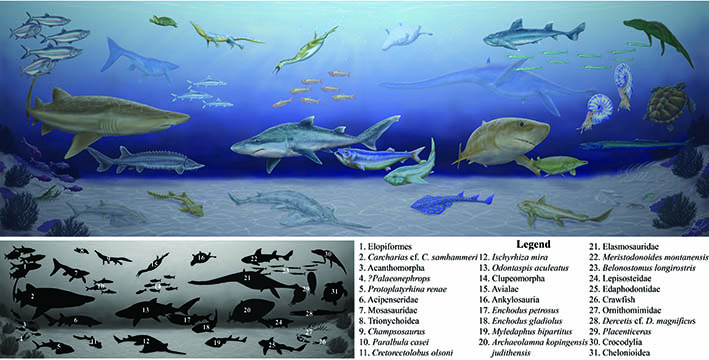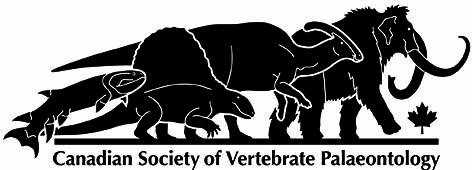First occurrence of the urocordylid Ctenerpeton remex from the Mazon Creek Lagerstätte, Illinois, USA
DOI:
https://doi.org/10.18435/vamp29411Keywords:
Nectridea, Permo-Carboniferous, Mazon Creek, tetrapod anatomy, UrocordylidaeAbstract
Despite being one of the most complete records of a paleozoic ecosystem, tetrapod fossils at the Mazon Creek Lagerstätte remain relatively rare compared to other contemporary late Carboniferous localities, making new additions to the fauna particularly important. Here we report a new concretion from Mazon Creek that contains a series of articulated caudal vertebrae of the early tetrapod Ctenerpeton remex. It is differentiated from Ptyonius and other nectrideans by the characteristics of its neural and haemal spines and arches, most notably the anterior and posterior projections on the haemal arches, the accessory zygapophyses on the neural arch, and the size and shape of the spines compared to known specimens of other urocordylids and nectrideans. The addition of Ctenerpeton remex to the Mazon Creek tetrapod assemblage increases the known diversity of nectrideans in this fauna and potentially aids in our understanding of the different environments inhabited by urocordylids in the late Carboniferous.
Downloads
References
Ahlberg, P.E. 1991. A re-examination of sarcopterygian interrelationships, with special reference to the Porolepiformes. Zoological Journal of the Linnean Society 103:241-287.
Bossy, K.H. 1976. Morphology, Paleontology, and Evolutionary Relationships of the Pennsylvanian Urocordylid Nectrideans (Subclass Lepospondyls, Class Amphibia). PhD dissertation, New Haven, CT: Yale University, New Haven, CT. 480 pp.
Carroll, R.L., K.A. Bossy, A.C. Milner, S.M. Andrews, and C.F. Wellstead. 1998. Encyclopedia of Paleoherpetology Part 1, Lepospondyli. München, Germany: Verlag Dr. Friedrich Pfeil. 216 pp.
Clements, T., M. Purnell, and S. Gabbott. 2018. The Mazon Creek Lagerstätte: a diverse late Paleozoic ecosystem entombed within siderite concretions. Journal of the Geological Society 176:1–11. DOI 10.1144/jgs2018-088
Cope, E.D. 1868. Synopsis of the extinct Batrachia of North America. Proceedings of the Academy of Natural Sciences of Philadelphia 1868:208–221.
Cope, E.D. 1897. On new Paleozoic Vertebrata from Illinois, Ohio and Pennsylvania. Proceedings of the American Philosophical Society 36:71–91.
Gregory, J.T., 1950. Tetrapods of the Pennsylvanian nodules from Mazon Creek, Illinois. American Journal of Science 248:833–873.
Hook, R.W., and D. Baird. 1986. The Diamond Coal Mine of Linton, Ohio and its Pennsylvanian-age vertebrates. Journal of Vertebrate Paleontology 6:174–190.
Hook, R.W., and D. Baird. 1993. A new fish and tetrapod assemblage from the Allegheny Group (Late Westphalian, Upper Carboniferous) of Eastern Ohio, U.S.A. Pollichia-Buch 29:143–154.
Hook, R.W., and J.C. Ferm. 1988. Paleoenvironmental controls on vertebrate-bearing abandoned channels in the Upper Carboniferous. Palaeogeography, Palaeoclimatology, Palaeoecology 63:159–181.
Huxley, T.H., and E.P. Wright. 1871. On a collection of fossil Vertebrata, from the Jarrow Colliery, County of Kilkenny, Ireland. Royal Irish Academy 24:351–370.
Mann, A., and H.C. Maddin. 2019. Diabloroter bolti, a short-bodied recumbirostran ‘microsaur’ from the Francis Creek Shale, Mazon Creek, Illinois. Zoological Journal of the Linnean Society 187:494–505. DOI 10.1093/zoolinnean/zlz025
Mann, A., J.D. Pardo, and H.C. Maddin. 2019. Infernovenator steenae, a new serpentine recumbirostran from the ‘Mazon Creek’ Lagerstätte further clarifies lysorophian origins. Zoological Journal of the Linnean Society 187:506-517. DOI 10.1093/zoolinnean/zlz026/5511658
Mann, A., E.J. McDaniel, E.R. McColville, and H.C. Maddin. 2019. Carbonodraco lundi gen et sp. nov., the oldest parareptile, from Linton, Ohio, and new insights into the early radiation of reptiles. Royal Society Open Science 6:191191. DOI 10.1098/rsos.191191
Mann, A. 2020. A systematic and ecomorphological investigation of the early amniotes from Mazon Creek, Francis Creek Shale, Illinois, USA. PhD dissertation, Carleton University, Ottawa, ON. 320 pp. DOI 10.22215/etd/2020-14283
Mann, A., and B.M. Gee. 2019. Lissamphibian-like toepads in an exceptionally preserved amphibamiform from Mazon Creek. Journal of Vertebrate Paleontology 39, e1727490. DOI 10.1080/02724634.2019.1727490
Mann, A., A.S Calthorpe, and H.C. Maddin. 2021. Joermungandr bolti, an exceptionally preserved ‘microsaur’from the Mazon Creek Lagerstätte reveals patterns of integumentary evolution in Recumbirostra. Royal Society Open Science 8, 210319. DOI 10.1098/rsos.210319
Mann, A., J.D. Pardo, and H.C. Maddin. 2022. Snake-like limb loss in a Carboniferous amniote. Nature Ecology & Evolution 6:614−621. DOI 10.1038/s41559-022-01698-y
Miall, L.C. 1875. Report of the committee on the structure and classification of the labyrinthodonts. Report of the 44th Meeting of the British Association for the Advancement of Science 1874:149–92.
Milner, A.R. 1982. Small temnospondyl amphibians from the Middle Pennsylvanian of Illinois. Paleontology 25:635–664.
Nicholson, H. A., and R. Lydekker. 1889. A Manual of Paleontology for the use of Students with a General Introduction on the Principles of Paleontology. 3rd ed. Edinburgh. 885 pp.
Romer, A.S. 1930. The Pennsylvanian tetrapods of Linton, Ohio. Bulletin of the American Museum of Natural History 59:78–134.
Shabica, C.W., and A.A. Hay. 1993. Richardson’s Guide to The Fossil Fauna of Mazon Creek. Northeastern Illinois University Chicago, IL. 308 pp.
Moodie, R.L. 1912. The Mazon Creek, Illinois, shales and their amphibian fauna. American Journal of Science 4:277–285.
Schiffbauer, J., G.C. Baird, J.W. Huntley, T. Selly, C.W. Shabica, M. LaFlamme, and A.D. Muscente. 2025. 283,821 concretions, how do you measure Mazon Creek? Assessing he paleoenvironmental and taphonomic nature of the Braidwood and Essex assemblages. Paleobiology 1−19. DOI 10.1017/pab.2025.10045
Downloads
Published
How to Cite
Issue
Section
License
Copyright (c) 2025 Arjan Mann, Blue Byrnes, John R. Bolt

This work is licensed under a Creative Commons Attribution 4.0 International License.
Submission of an article to Vertebrate Anatomy Morphology Palaeontology will be taken to mean that the article is an original work and not previously published or under consideration for publication elsewhere.
If the article is accepted for publication, it will be published on-line under Creative Commons Attribution 4.0 International (CC By 4.0) meaning:
Attribution — You must give appropriate credit, provide a link to the license, and indicate if changes were made. You may do so in any reasonable manner, but not in any way that suggests the licensor endorses you or your use.
No additional restrictions — You may not apply legal terms or technological measures that legally restrict others from doing anything the license permits.







